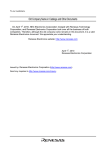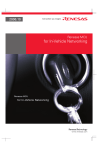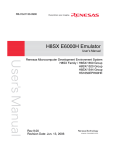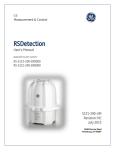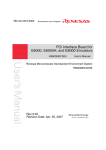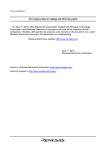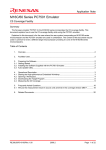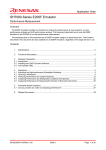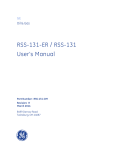Download Renesas H8SX/1651 Specifications
Transcript
Application Note H8SX Family Emulator E6000H Usage of Realtime RAM Monitoring Overview This document describes how to use the RAM monitoring function which displays the memory contents during realtime execution of the user program in the full-specification emulator E6000H for the H8SX/1651. The functions described in this document can be performed through the H8SX E6000H emulator in a stand-alone form. These functions are also available through all E6000H emulators for the H8SX family. Contents 1. Specifications .................................................................................................................................. 2 2. Functional Descriptions ................................................................................................................. 2 3. 3.1 3.2 3.3 Software Preparation ...................................................................................................................... 2 Introduction ..................................................................................................................................... 2 Installing the H8SX E6000H Emulator Software........................................................................... 3 Installing Other Necessary Software............................................................................................. 5 4. 4.1 4.2 4.3 4.4 4.5 4.6 4.7 4.8 Operations ....................................................................................................................................... 6 Activating the High-Performance Embedded Workshop ............................................................ 6 Opening a Workspace .................................................................................................................... 7 Connecting the E6000H Emulator ............................................................................................... 11 Downloading a Program............................................................................................................... 15 Opening a Source File .................................................................................................................. 16 Setting a Monitor Condition ......................................................................................................... 17 Executing a Program .................................................................................................................... 19 Checking the Monitor Display...................................................................................................... 20 5. Related Documents....................................................................................................................... 21 REJ06J0024-0100/Rev.1.00 July 2007 Page 1 of 23 H8SX Family Emulator E6000H Usage of Realtime RAM Monitoring 1. Specifications The E6000H emulator provides the RAM monitoring function to display the memory contents during realtime execution of the user program. In this monitoring function, the realtime operation is retained since the bus monitoring circuit of the emulator sets the read/write signal of the MCU as a trigger and holds the address bus and data bus values to update the displayed contents of memory. Up to eight points or 256 bytes in total can be set by using the eight monitoring channels on the bus monitoring circuit. It is possible that a part or all of monitoring ranges is overlapped. Notes: 1. 2. 2. Monitoring is impossible for an area, such as an on-chip timer counter, where no internal write signal is generated to update a value. The procedure to display or modify the contents of memory differs depending on the product. If the display of memory contents is updated during execution of the user program, realtime emulation may not be available. For details, refer to section 5.4, Displaying and Modifying the Contents of Memory, in the H8SX E6000H Emulator User's Manual. Functional Descriptions This document describes how to use the RAM monitoring function in the H8SX/1651 E6000H emulator. It guides you through examples of the setting of the realtime RAM monitoring function in the sample program provided in the CD-ROM of the H8SX E6000H emulator. Check that the memory contents have been changed on the [Monitor] window during program execution. 3. 3.1 Software Preparation Introduction Install the software provided in the CD-ROM of the H8SX E6000H emulator to expand the sample program (tutorial workspace) to be used in this document on your personal computer. The software in the CD-ROM of the H8SX E6000H emulator can also be installed in a personal computer in which the High-performance Embedded Workshop has already been installed. In this case, some dialog boxes may be skipped in the installation process. If the software has already been installed, go to section 4. REJ06J0024-0100/Rev.1.00 July 2007 Page 2 of 23 H8SX Family Emulator E6000H Usage of Realtime RAM Monitoring 3.2 Installing the H8SX E6000H Emulator Software (1) Execute setup.exe from the CD-ROM of the H8SX E6000H emulator. The whole screen is displayed and installation of [H8SX E6000H Emulator] is started. Click the [Next] button. (2) The [License Agreement] dialog box will appear. Read the contents and click the [Yes] button. REJ06J0024-0100/Rev.1.00 July 2007 Page 3 of 23 H8SX Family Emulator E6000H Usage of Realtime RAM Monitoring (3) The [Start Copying Files] dialog box will appear. Click the [Next] button. (4) The following progress bar will be displayed while the program files are being copied. REJ06J0024-0100/Rev.1.00 July 2007 Page 4 of 23 H8SX Family Emulator E6000H Usage of Realtime RAM Monitoring (5) The [InstallShield Wizard Complete] dialog box will appear. Click the [Finish] button. This is the end of software preparation. 3.3 Installing Other Necessary Software For the host interface board, which is an optional board for the H8SX E6000H emulator, install the necessary software according to the connection type (PCI card, PC card, LAN adaptor, or USB adaptor). The installation procedure is described in the manual supplied with the optional product; it is not described in this document. REJ06J0024-0100/Rev.1.00 July 2007 Page 5 of 23 H8SX Family Emulator E6000H Usage of Realtime RAM Monitoring 4. Operations This section describes how to activate the High-performance Embedded Workshop (HEW) and how to use the realtime RAM monitoring function in the following steps. START Activating the HEW Opening a Workspace Connecting the E6000H Emulator Downloading a Program Opening a Source File Setting a Monitor Condition Executing a Program Checking the Monitor Display END Figure 4.1 4.1 Procedures for Sample Program Execution Activating the High-Performance Embedded Workshop Activate the High-performance Embedded Workshop by opening the [Start] menu and selecting [All Programs], [Renesas], [High-performance Embedded Workshop], and [High-performance Embedded Workshop] in that order. REJ06J0024-0100/Rev.1.00 July 2007 Page 6 of 23 H8SX Family Emulator E6000H Usage of Realtime RAM Monitoring 4.2 Opening a Workspace (1) The [Welcome!] dialog box will appear on the High-performance Embedded Workshop screen. Select the [Browse to another project workspace] radio button in the [Welcome!] dialog box and click the [OK] button. REJ06J0024-0100/Rev.1.00 July 2007 Page 7 of 23 H8SX Family Emulator E6000H Usage of Realtime RAM Monitoring (2) The [Open Workspace] dialog box will appear. When the software from the CD-ROM of this product has been installed, workspace "Tutorial.hws" is stored in the folder structure shown below (standard location). Specify the correct location by opening the folders in order. Select the workspace "Tutorial.hws" and click the [Open] button. C:\WorkSpace\Tutorial\E6000H\1650\Tutorial.hws C:\WorkSpace └Tutorial └E6000H └1650 └Tutorial.hws Note: The above directory may not be specifiable depending on the software version. In this case, select the following directory. <High-performance Embedded Workshop installation directory> \Tools\Renesas\DebugComp\Platform\E6000H\1650\Tutorial Directory examples: C:\hew3\Tools\Renesas\DebugComp\Platform\E6000H\1650\Tutorial C:\hew2\Tools\Renesas\DebugComp\Platform\E6000H\1650\Tutorial (3) If the workspace version is old, the following dialog box will appear. To update it to the new version, click the [OK] button. REJ06J0024-0100/Rev.1.00 July 2007 Page 8 of 23 H8SX Family Emulator E6000H Usage of Realtime RAM Monitoring (4) If the [Toolchain missing] dialog box appears, select the target project name and click the [OK] button. (5) If the [Changing Toolchain Version] dialog box appears, select the desired toolchain version and click the [OK] button. REJ06J0024-0100/Rev.1.00 July 2007 Page 9 of 23 H8SX Family Emulator E6000H Usage of Realtime RAM Monitoring (6) If the [Change Toolchain Version Summary] dialog box appears, just click the [OK] button. (7) After the workspace has been read, operation on the High-performance Embedded Workshop screen becomes available. REJ06J0024-0100/Rev.1.00 July 2007 Page 10 of 23 H8SX Family Emulator E6000H Usage of Realtime RAM Monitoring 4.3 Connecting the E6000H Emulator (1) Open [Debug Session] from the [Debug] menu. (2) The [Debug Session] dialog box will appear. Select [sessionh8sx_1650_e6000h_emulator] for [Current Session] and click the [OK] button. REJ06J0024-0100/Rev.1.00 July 2007 Page 11 of 23 H8SX Family Emulator E6000H Usage of Realtime RAM Monitoring (3) The [Change Session] dialog box will appear. Click the [Yes] button. (4) The display of the session on the toolbar is changed as [sessionh8sx_1527R_e6000h_emulator]. REJ06J0024-0100/Rev.1.00 July 2007 Page 12 of 23 H8SX Family Emulator E6000H Usage of Realtime RAM Monitoring (5) Turn on the E6000H emulator and click [Connect] from the [Debug] menu. (6) The [Connecting] dialog box is displayed while the E6000H emulator is connected. The [E6000H Driver Details] dialog box may be shown when connecting the E6000H emulator. In this case, select the driver in use and click the [Close] button. REJ06J0024-0100/Rev.1.00 July 2007 Page 13 of 23 H8SX Family Emulator E6000H Usage of Realtime RAM Monitoring (7) When the E6000H emulator is connected, [Connected] is displayed on the [Debug] tab. REJ06J0024-0100/Rev.1.00 July 2007 Page 14 of 23 H8SX Family Emulator E6000H Usage of Realtime RAM Monitoring 4.4 Downloading a Program (1) Select [Download Modules] form the [Debug] menu to load the sample program. Select the file "Tutorial.abs" registered in the workspace. (2) After downloading a program completes, a downward arrow is added to the icon left to the file name. REJ06J0024-0100/Rev.1.00 July 2007 Page 15 of 23 H8SX Family Emulator E6000H Usage of Realtime RAM Monitoring 4.5 (1) Opening a Source File Double-click the source file name on the workspace to open the source code. Here, select the file "sort.cpp". (2) Move the mouse pointer on the [Source] window and point to the position of symbol 'a' on line 55 in the source file "SORT.CPP". Point the position of symbol ‘a’. While pointing to the same position, the [Source] window shows the variable-type information and allocated addresses of symbol 'a' near the mouse. Thus the address of the symbol can be checked on the source file. REJ06J0024-0100/Rev.1.00 July 2007 Page 16 of 23 H8SX Family Emulator E6000H Usage of Realtime RAM Monitoring 4.6 Setting a Monitor Condition (1) Select [CPU] from the [View] menu and then [Monitor Setting...] from [Monitor]. (2) The [Monitor Setting] dialog box will appear. Click the [Label Select] button right to the [Address] combo box. REJ06J0024-0100/Rev.1.00 July 2007 Page 17 of 23 H8SX Family Emulator E6000H Usage of Realtime RAM Monitoring (3) The [Label Select] dialog box will appear. Here, find and select label "_a" and click the [OK] button. For the [Label] column in the [Label Select] dialog box, an underline '_' (ASCII code: h'5F) is added to the beginning of symbol names on the source line. The physical addresses of labels are registered in the [Address] column. Only labels which have static addresses are registered in the [Label Select] dialog box. It is not possible to refer to local variables of the C language because they are dynamic variables which are not registered in this dialog box. (4) Check that the label name selected in (3) above has been entered in [Address] of the [Monitor Setting] dialog box. The [Auto-Refresh at rate] is set as 250 ms. Click the [OK] button. REJ06J0024-0100/Rev.1.00 July 2007 Page 18 of 23 H8SX Family Emulator E6000H Usage of Realtime RAM Monitoring (5) The [Monitor] window is added to the High-performance Embedded Workshop. The label addresses selected in (3) above have been registered in [Address]. [Monitor] window This is the end of setting of the realtime RAM monitoring function. 4.7 (1) Executing a Program Select [Reset Go] from the [Debug] menu to execute a program. REJ06J0024-0100/Rev.1.00 July 2007 Page 19 of 23 H8SX Family Emulator E6000H Usage of Realtime RAM Monitoring 4.8 (1) Checking the Monitor Display During user program execution, depending on the program, when the display of the [Monitor] window is updated after data has been written within the target address range, the display of memory contents will be changed. The display of memory contens will be changed. Update interval (ms) Address bus and status signals The update interval is displayed in the ms unit on the title position of the [Address] column in the [Monitor] window. The value of the update interval is based on the interval value specified for the auto-update interval (refer to the description on the [Monitor Setting] dialog box in section 4.6, Setting a Monitor Condition). Actually, the update timing will be late because of an overhead of the processing. The execution states of address bus and status signals are displayed in realtime at the lower left of the status bar. In addition, it is possible to customize the [Color] group box or [Access] combo box. For details on the displayed contents and the operation of the [Monitor] window, refer to the H8SX E6000H Emulator User's Manual that is listed in section 5, Related Documents. To halt the user program, press the [Esc] key. REJ06J0024-0100/Rev.1.00 July 2007 Page 20 of 23 H8SX Family Emulator E6000H Usage of Realtime RAM Monitoring 5. Related Documents The H8SX E6000H emulator and High-performance Embedded Workshop provide many other useful functions not mentioned in this document. Please refer to the following related documents for important information such as detailed specifications, technical information, or restrictions. Documents Related to the H8SX/1651 E6000H Emulator: • H8SX E6000H Emulator User's Manual Debugger Part: Section 3.7, Using the Event Points Tutorial: Section 4.17, Trace Functions • Precautions on Using the H8SX E6000H Emulator • PC Card Interface for E6000, E6000H and E8000 Emulators HS6000EIP02H User's Manual • Emulator Options 1 (PC I/F-part) documents Document Related to High-Performance Embedded Workshop: • High-performance Embedded Workshop User's Manual Documents Related to CPU: • H8SX/1651 Group Hardware Manual • H8SX Family Software Manual Documents Related to H8S, H8/300 Series C/C++ Compiler Package: • Notes on Usage of the C/C++ Compiler Package for H8SX, H8S, H8 Family V.6.01 Release 02 and Corrections in the User's Manual • H8S, H8/300 Series C/C++ Compiler, Assembler, Optimizing Linkage Editor User's Manual Visit the following Renesas websites for information on this product: Japanese site: http://japan.renesas.com/e6000h Global site: http://www.renesas.com/e6000h REJ06J0024-0100/Rev.1.00 July 2007 Page 21 of 23 H8SX Family Emulator E6000H Usage of Realtime RAM Monitoring Renesas Website and Customer Support Renesas Technology Website: http://www.renesas.com/ Customer Support: http://www.renesas.com/inquiry [email protected] Revision History Rev. 1.00 Publication date Jul 09, 2007 REJ06J0024-0100/Rev.1.00 Page — Revisions Description First edition July 2007 Page 22 of 23 H8SX Family Emulator E6000H Usage of Realtime RAM Monitoring Notes regarding these materials 1. 2. 3. 4. 5. 6. 7. 8. 9. 10. 11. 12. 13. This document is provided for reference purposes only so that Renesas customers may select the appropriate Renesas products for their use. Renesas neither makes warranties or representations with respect to the accuracy or completeness of the information contained in this document nor grants any license to any intellectual property rights or any other rights of Renesas or any third party with respect to the information in this document. Renesas shall have no liability for damages or infringement of any intellectual property or other rights arising out of the use of any information in this document, including, but not limited to, product data, diagrams, charts, programs, algorithms, and application circuit examples. You should not use the products or the technology described in this document for the purpose of military applications such as the development of weapons of mass destruction or for the purpose of any other military use. When exporting the products or technology described herein, you should follow the applicable export control laws and regulations, and procedures required by such laws and regulations. All information included in this document such as product data, diagrams, charts, programs, algorithms, and application circuit examples, is current as of the date this document is issued. Such information, however, is subject to change without any prior notice. Before purchasing or using any Renesas products listed in this document, please confirm the latest product information with a Renesas sales office. Also, please pay regular and careful attention to additional and different information to be disclosed by Renesas such as that disclosed through our website. (http://www.renesas.com ) Renesas has used reasonable care in compiling the information included in this document, but Renesas assumes no liability whatsoever for any damages incurred as a result of errors or omissions in the information included in this document. When using or otherwise relying on the information in this document, you should evaluate the information in light of the total system before deciding about the applicability of such information to the intended application. Renesas makes no representations, warranties or guaranties regarding the suitability of its products for any particular application and specifically disclaims any liability arising out of the application and use of the information in this document or Renesas products. With the exception of products specified by Renesas as suitable for automobile applications, Renesas products are not designed, manufactured or tested for applications or otherwise in systems the failure or malfunction of which may cause a direct threat to human life or create a risk of human injury or which require especially high quality and reliability such as safety systems, or equipment or systems for transportation and traffic, healthcare, combustion control, aerospace and aeronautics, nuclear power, or undersea communication transmission. If you are considering the use of our products for such purposes, please contact a Renesas sales office beforehand. Renesas shall have no liability for damages arising out of the uses set forth above. Notwithstanding the preceding paragraph, you should not use Renesas products for the purposes listed below: 1) artificial life support devices or systems 2) surgical implantations 3) healthcare intervention (e.g., excision, administration of medication, etc.) 4) any other purposes that pose a direct threat to human life Renesas shall have no liability for damages arising out of the uses set forth in the above and purchasers who elect to use Renesas products in any of the foregoing applications shall indemnify and hold harmless Renesas Technology Corp., its affiliated companies and their officers, directors, and employees against any and all damages arising out of such applications. You should use the products described herein within the range specified by Renesas, especially with respect to the maximum rating, operating supply voltage range, movement power voltage range, heat radiation characteristics, installation and other product characteristics. Renesas shall have no liability for malfunctions or damages arising out of the use of Renesas products beyond such specified ranges. Although Renesas endeavors to improve the quality and reliability of its products, IC products have specific characteristics such as the occurrence of failure at a certain rate and malfunctions under certain use conditions. Please be sure to implement safety measures to guard against the possibility of physical injury, and injury or damage caused by fire in the event of the failure of a Renesas product, such as safety design for hardware and software including but not limited to redundancy, fire control and malfunction prevention, appropriate treatment for aging degradation or any other applicable measures. Among others, since the evaluation of microcomputer software alone is very difficult, please evaluate the safety of the final products or system manufactured by you. In case Renesas products listed in this document are detached from the products to which the Renesas products are attached or affixed, the risk of accident such as swallowing by infants and small children is very high. You should implement safety measures so that Renesas products may not be easily detached from your products. Renesas shall have no liability for damages arising out of such detachment. You should not use the products or the technology described in this document for the purpose of military applications such as the development of weapons of mass destruction or for the purpose of any other military use. When exporting the products or technology described herein, you should follow the applicable export control laws and regulations, and procedures required by such laws and regulations. Please contact a Renesas sales office if you have any questions regarding the information contained in this document, Renesas semiconductor products, or if you have any other inquiries. (c) 2007. Renesas Technology Corp., All rights reserved. REJ06J0024-0100/Rev.1.00 July 2007 Page 23 of 23
























